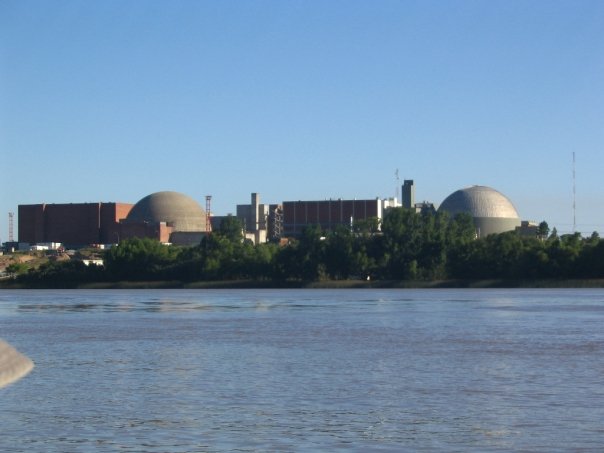A terminal uranium nitride compound create which is stable at room temperature and easy to stored
4 July, 2012
Scientists create ‘trophy molecule’ that could revolutionise nuclear industry. cordis.europa.eu. July 03, 2012. Researchers have created a stable version of a ‘trophy molecule’ that has eluded scientists for decades and could lead to the production of cleaner nuclear energy. Writing in the journal Science, the team, made up of scientists from the universities of Nottingham and Manchester in the United Kingdom, show that they can prepare a terminal uranium nitride compound which is stable at room temperature. Moreover, they prove that the compound can be stored in jars in crystallised or powder form.

Atucha desde el Paraná
The study was supported in part by the EU-funded project UNCLE (‘Uranium in non-conventional ligand environments’), which received a EUR 999996 Starting Grant from the European Research Council (ERC).
The researchers report that the breakthrough could have future implications for the nuclear energy industry as uranium nitride materials may potentially offer a viable alternative to the current mixed oxide nuclear fuels used in reactors since nitrides exhibit superior high densities, melting points and thermal conductivities. In addition, the process the scientists used to make the compound could offer a cleaner, lower temperature route than the methods currently used.
Previous attempts to prepare uranium-nitrogen triple bonds have required temperatures as low as 5 Kelvin (-268 Celsius) – roughly the equivalent temperature of interstellar space – and have therefore been difficult to work with and manipulate, requiring specialist equipment and techniques.
Uranium nitrides are usually prepared by mixing dinitrogen or ammonia with uranium under high temperatures and pressures. Unfortunately, however, the harsh reaction conditions used in the preparation introduce impurities which are difficult to remove, say the researchers. In recent years scientists have therefore focused their attention on using low-temperature, molecular methods; but all previous attempts resulted in bridging, rather than the target terminal, nitrides.
The method used in this study involved using a very ‘bulky’ nitrogen ligand (an organic molecule bonded to a metal) to wrap around the uranium centre and to create a protective pocket in which the nitride nitrogen can sit. The nitride was stabilised during the synthesis by the presence of a weakly bound sodium cation (positively charged ion) which blocked the nitride from reacting with any other elements. In the final stage, the sodium was gently teased away, removing it from the structure and leaving the final, stable uranium nitride triple bond.
Dr Stephen Liddle from Nottingham University comments: ‘The beauty of this work is its simplicity – by encapsulating the uranium nitride with a very bulky supporting ligand, stabilising the nitride during synthesis with sodium and then sequestering the sodium under mild conditions we were able to at long last isolate the terminal uranium nitride linkage.
‘A major motivation for doing this work was to help us to understand the nature and extent of the covalency in the chemical bonding of uranium. This is fundamentally interesting and important because it could help in work to extract and separate the 2-3% of the highly radioactive material in nuclear waste.’
Professor Eric McInnes, from Manchester University adds that electron paramagnetic resonance (EPR) spectroscopy, the technique used by the team to study materials with unpaired electrons, ‘can give detailed information about the local environment of unpaired electrons, and this can be used to understand the electronic structure of the uranium ion in this new nitride’.
‘It turns out that the new nitride behaves differently from some otherwise analogous materials, and this might have important implications in actinide chemistry which is of vital technological and environmental importance in the nuclear fuel cycle,’ he concludes.
For more information, please visit:
University of Nottingham:
